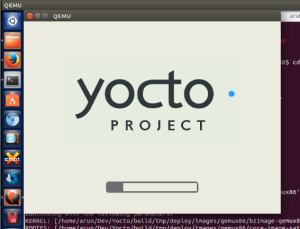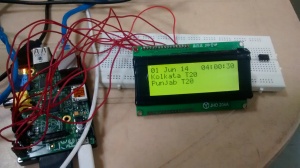# Python script to display the latest scores
# Arun Kumar @ArunMKumar
# Varun Gupta varun90gupta@gmail.com
# Anish Tambe @atdaemon
# 01.06.2014
######################## Libraries ##############################
from __future__ import print_function, division, absolute_import, unicode_literals
from RPLCD import *
import httplib
import time
import re
####################### Constatnts #############################
teams = ["England", "India", "Sri Lanka", "West Indies", "Punjab T", "Chennai T", "Yorkshire", "Hampshire", "Surrey", "Sussex" ]
rows = {"time" : 0 , "team1" : 1 , "team2" : 2 , "player" : 3}
colm = {"teamname": 0 ,"score": 12, "time": 11}
namelen = 7
###################### functions ##############################
display = None
def initLCD():
global display
display =CharLCD()
display.clear()
display.cursor_mode = CursorMode.blink
def getMatchList():
Con = httplib.HTTPConnection('cricscore-api.appspot.com')
Con.request("GET", "/csa")
Response = Con.getresponse()
return eval(Response.read()) ## Disputed
def getFavsIds(matchesList,favTeams) :
favs = []
for match in matchesList :
if match['t1'] in favTeams or match['t2'] in favTeams :
favs.append(match['id'])
return favs
def getMatchScore(matchId):
Con = httplib.HTTPConnection('cricscore-api.appspot.com')
Con.request("GET", "/csa?id="+"+".join(map(str,matchId)))
Response = Con.getresponse()
return eval(Response.read()) ## Disputed
def getTeamNameandScores(status):
Result = re.search("([a-zA-Z\ ]+).*([0-9]+\/[0-9]+)*[\ \*]*v([a-zA-Z\ ]+).*([0-9]+\/[0-9]+)*",status)
names = [Result.group(1), Result.group(2), Result.group(3), Result.group(4)]
return names
def displaytime():
global display
display.cursor_pos = (0,0)
Current_Time =time.strftime("%d %b %y")
display.write_string(Current_Time)
display.cursor_pos = (rows['time'], colm['time'])
Current_Time = time.strftime(" %H:%M:%S")
display.write_string(Current_Time)
###############################################################################
initLCD()
#Get list of matches
matches = getMatchList()
#Get the Match ID
matchIds = getFavsIds(matches, teams)
#get the status for all matches
statuses = getMatchScore(matchIds) # all scores
print(statuses)
# Display Scores
for status in statuses:
nameAndScore = getTeamNameandScores(status['si'])
display.clear()
displaytime()
if nameAndScore[0]:
display.cursor_pos = (rows["team1"],colm['teamname'])
display.write_string(nameAndScore[0].strip()[:namelen])
if nameAndScore[1]:
display.cursor_pos = (rows["team1"],colm['score'])
display.write_string(nameAndScore[1].strip())
if nameAndScore[2]:
display.cursor_pos = (rows["team2"],colm['teamname'])
display.write_string(nameAndScore[2].strip()[:namelen])
if nameAndScore[3]:
display.cursor_pos = (rows["team2"],colm['score'])
display.write_string(nameAndScore[3].strip())
time.sleep(60/len(matchIds)) # sleep accordingly





